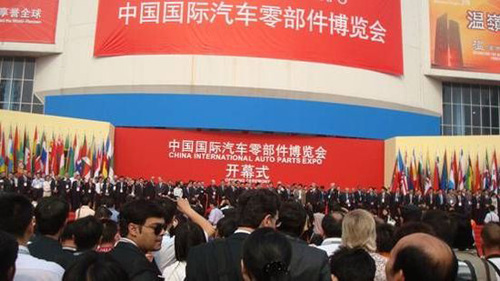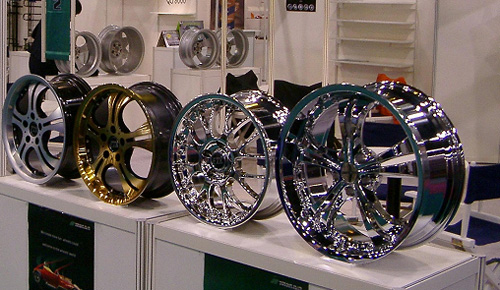China's Auto Parts Sector Sees Rapid Growth Driven by Car Market
2011/08/26 | By Michelle Hsu
The China Motor Magazine says over 20,000 auto parts makers are in China, some 8,000 of which are “large.” With auto-making drawing considerable investment and interest since the 1990s, auto parts production has also spread to every province and major city in China, where each new car-making plant has been set up with satellite auto parts makers with OEM capacity to serve local carmakers and roll out parts for export.
Lower Margins
As with any emerging market that draws intensive investment from carmakers worldwide, China's carmakers and dealers have been competing for market share by underselling that has backfired with drastically lower profit margin over the past few years, a phenomenon that has, however, not impacted the auto parts sector's relatively stable profit margin to keep attracting continued investments. One reason may be that drivers, due to warranty requirements, desired performance and safety, must replace headlamps and filters, for examples, with OE parts, which helps to keep parts prices steady.
Latest statistics show that China's auto parts sales reached 436.3 billion RMB during the first quarter of this year, up 20.06% from a year earlier, despite slowing car sales.
Trying to further develop the fast-growing domestic auto parts market, China's Ministry of Commerce has been since 2007 hosting in Beijing the annual China International Auto Parts Expo (CIAPE), the largest international auto parts expo in the nation, which aims to be one of the world's leading auto parts shows. Somehow unaffected by the weakening auto markets in the U.S. and Europe, CIAPE, held in September, has quickly expanded over the past few years, due partly to participation by the world's major auto parts makers.
Delphi Corporation, for example, is a regular exhibitor yearly, with the US-headquartered maker expanding operations in Asia, which will account for one-third of its global operations and most from China.
BorgWarner, a global technology leader in powertrain solutions, is another big-name participant, adopting the CIAPE as a major platform to introduce new products and technologies to both Chinese and international buyers.
With the Shanghai and Beijing auto shows already developed as world-class auto shows in Asia, China's Ministry of Commerce expects the same level of success for the CIAPE, whose 2011 version is slated for Sept 8-10 and again expected to be specially attractive to those interested in the Asian market.
Leading Maker
Even before becoming the world's biggest carmaker, China had garnered the largest slice of the American auto parts aftermarket, being the largest maker of aluminum wheels globally with annual production exceeding 80 million pieces in 2010, of which around 50% were exported.

Electric fuel injection systems and engines, for examples, are all foreign-venture-made while foreign ventures also “control” 97% of key parts like ABS and 69% of airbags. The top-6 suppliers of airbags are foreign ventures, which account for 83% of annual production in China, where around 78% of automatic transmissions are imported.
According to the Magazine, foreign ventures generated some 54% of auto parts sales in 2010. Over 70% of the world's top-100 auto parts makers have production lines in China, where over 1,200 auto parts foreign ventures exist to take a market share of 60%, with 2010 revenue topping 90 billion RMB or around 54% of total revenue generated in China.
The Magazine also cites a piece of data: “No Chinese firms but three Korean ventures are among the world's top-100 global auto parts makers.”
Developing Independence
To reduce reliance on foreign ventures for key parts, which is critical to shaping development of the nation's car-making, auto-parts sectors and their profitability, China's auto parts sector aims as the next strategy to upgrade technologies.
And Guangdong Province is setting example by announcing in May to build in Zhungshan City the largest lithium battery factory in China to be the base to support development of the nation's new energy cars in the future, which, if successfully set up, will help not only to lift Guangdong's position in China's auto industry but also sanitize the provincial image as a low-end auto parts production area. And to take its auto parts sector up the supply chain, Guangdong Province began mapping two years ago the path of development, primarily focusing on key parts design and production.
Acquisitions as Shortcut
While developing higher-end technologies of their own, China's auto parts makers remains active in acquiring foreign counterparts as a shortcut for technology transfer and international sales network expansion.
In June, Chongqing Light Industry & Textile Holding Co. (CQLT) announced its acquisition of Germany's Saargummi for 68 million euros. Saargummi is a leading sealing system supplier in Europe, providing full service of sealing systems for the automotive industry from materials development through product design to realization of complex sealing systems, with operations extending from home to Spain, Czech Republic, Slovakia, Brazil, the USA, as well as joint ventures in China, India, Russia and Croatia.
The acquisition will upgrade CQLT's technologies with not only the German company's sealing systems but also enable access to well-established sales network globally.
Earlier in April, AVIC Automobile Industry Holding Company, a state-owned venture in China, announced its acquisition completed in April, along with Beijing E-Town International Investment & Development Co. (E-Town), Nexteer Automotive, a subsidiary of General Motors—the single largest Chinese investment in the global auto parts industry. Nexteer is a global leading supplier of advanced steering and driveline systems.
AVIC will house Nexteer's worldwide headquarters, key center for engineering, research and development, with its current management team to be under the leadership of Robert J. Remenar, CEO, Nexteer Automotive.
Nexteer's business includes global steering and half shaft operations in 22 manufacturing facilities, six engineering facilities and 14 customer support centers in North and South Americas, Europe and Asia, with customers as GM, Fiat, Ford, Toyota, Chrysler, and PSA Peugeot Citroen, as well as automakers in India, China and South America. “We are committed to building on the hard work and success of the management team and everyone at Nexteer,” said AVIC Chairman Zhao Guangyi. “As the new ownership, we are proud to provide access to continued capital investment that will allow Nexteer to continue its global growth in technology and manufacturing, particularly in the China market.”




